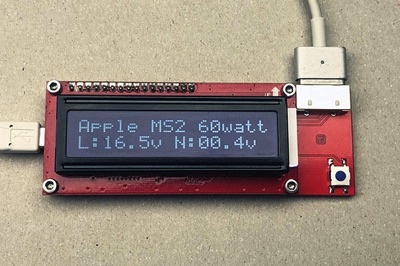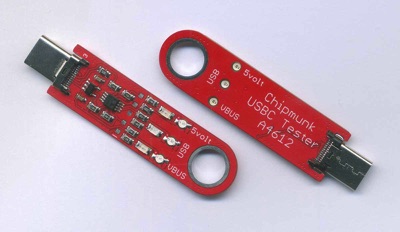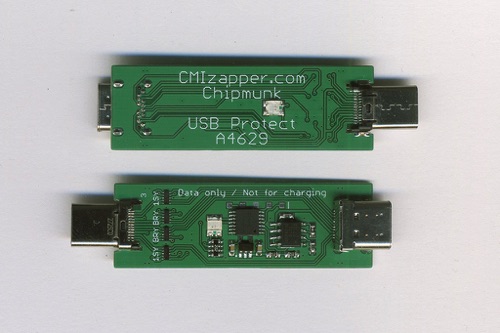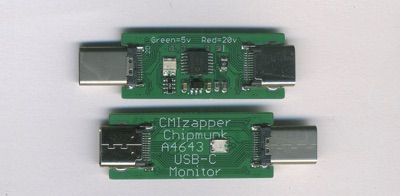The Medusa is our line of tools to play with the EFI ROM. The tool you need when repairing boards and you want to see the serial number or the firmware version without putting the board in a Mac or when you forgot your EFI PIN and locked yourself out of your Mac.
It is incredibly easy to use. The built in LCD display will show you what is going on.
1) Display info from the EFI ROM:
ROM chip model, ROM chip size, Mac Firmware version, ME version, EFI lock state, Mac serial Number, production date and time... and many many more options!
Click on the link to learn more...
USB-C (voltage) Monitor (A4643)
Our line of diagnostic tools is designed to quickly give you useful information about the computer you are working on, with a minimal amount of effort.
This is a simple but extremely useful tool that monitors the voltage on the USB-C bus.
With all Apple computers the charger should start with 5 volts and then switch up to 20 volts once communication between the charger and the computer has been established. The charger switching up to 20 volts is the easy way to see that this communication is working.
For more safety there is a (self resetting) 4 Amp fuse.
All data lines are connected from one side to the other.
The LED lights up green if the voltage is 5 volts and red if the voltage is 20 volts. The LED is mounted on both sides of the board so that you can always see it, also if you turn the motherboard/computer upside down.
The CMIzapper MagSafe Tester is a small tool for the repair workshop. It is especially useful to show the customer that their crappy charger is in fact a crappy charger...
You can connect any MagSafe (1 or 2) power adapter to this tool.
This tester will show you if it is a real Apple or a fake Chinese adapter!
It will also show the output voltage both with and without load. A decent (read Apple) adapter will have a no-load output voltage of about 6 volts or less and will only turn on the full voltage of about 18 volts once it 'smells' that it is connected to a MacBook.
The big idea with this tester is that you plug it into any laptop or motherboard (Apple or Windows) you are repairing. With one second of extra work it will give you all sorts of extra information about what is going on with the device, and sometimes it will save you big-time. For example you will aware of when the board is powered so you will not plug or unplug the internal LCD cable by accident with the power still on. Also differentiating between a machine that turns on but shows no image and a machine that does not turn on becomes trivial.
This is a simple but extremely useful tool for anyone repairing computers and laptops. It has 3 lights showing power and USB activity, and it offers a versatile connection to the GND line of the computer.
Click on the link to learn more...

This is a simple but extremely useful tool for anyone repairing computers and laptops.
It has 3 lights showing power and USB activity.
The VBUS LED (red) is connected straight to the VBUS line and will light up whenever power is present. On USB-C ports it is the responsibility of the CD321x chip to turn the 5v on, this light implies that the the CD321x is at least partially working.
The USB LED (green) will blink whenever there is activity on the USB bus. As the USB bus on a computer is driven by the PCH, this will indicate that at least the PCH and probably also the CPU is running.
The 5volt LED (red) will only light up if the VBUS voltage is correct i.e. if it is below 4.75 volt it will be off. Above 5.4 volt it will blink to draw your attention to the danger that USB-C port would be to anything else you would plug in there.


This simple tool protects your USB-C device (Drive, SSD, etc) when you plug it into a computer with a bad USB-C port.
The newer MacBooks with USB-C have a nasty tendency to output 20 volts on the USB-C port when a CD32xx chip in the computer dies. That in turn will kill the drive that you plugged into the USB-C port to test the machine...
This tool has a LED on both sides of the board. If the output voltage is above 5.4 volts the red LED will light up to warn you and it will NOT pass that voltage onto the other side. Only if the voltage is correct (i.e. 5 volts) the voltage will be passed through and the LED will light up green.
There is also some extra protection (ESD diodes) on the data lines. With some luck those will protect your data lines if there are wrong voltages there, but this is less than a full protection. (But much more than nothing.)
A4629: 65 euro
All prices include shipping world wide.

Normal price 40 Euro.
Now for the introduction price of only 16 euro including shipping! (normal price 40 euro)